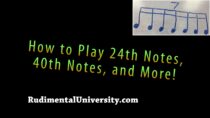Today we focus on building fast singles! In part 1, we covered playing zones and basic movement. In part 2, we covered basic around patterns. Now, we build upon this foundation and start Read more “How to Play Marching Tenor Drums, Part 3 of 7: Building Fast Singles”
Tag: triplets
How to Play 24th Notes, 40th Notes, and More!
Do you know how to count 24th notes, 40th notes, or 48th notes? James walks you through some terminology that may just revolutionize your understanding of rhythm. The following is a modified transcript of the video above:
***************************
Hello, everybody. This is James Christian with RudimentalUniversity.com.
Today I want to talk about rhythm terminology. Most musicians don’t frequently deal with this particular concept I’m going to discuss, but drummers and percussionists deal with it all the time.
We’re used to whole notes, half notes, quarter, notes, 8th notes, 16th notes, etc. And we also have tuplet patterns, such as half note triplets, quarter note triplets, 8th note triplets, 16th note triplets, and so forth. In this article, I’m going to talk about the way we discuss tuplet patterns and how we can make it a little bit easier.
This method is especially easier when you’re writing on the Internet and typing. It also makes your terminology more consistent, regardless of the type of note you’re discussing. When you’re writing, this method will save space, and it’s just a nice shorthand for your terminology.
So here it is… Read more “How to Play 24th Notes, 40th Notes, and More!”
Bass Drum Splitting Exercise: 12 Bucks
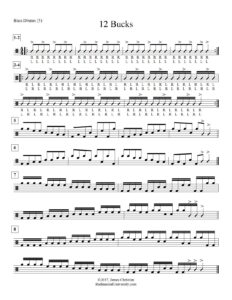
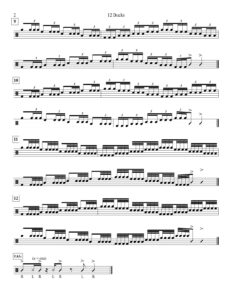
This fun bass exercise can be played with the snare and tenor exercises posted yesterday, or it can stand alone as a good splitting workout for five players. As the title indicates, there are 12 sections, and each has a specific focus:
- Sections 1-2: Unison one-handed accented 8th notes. Focus on maintaining a clear distinction between accents and taps. Keep your taps controlled and close to the drum. Make sure your accents are strong, not wimpy. Matching stick heights and angles will help in staying together.
- Sections 3-4: Unison alternating accented 16th notes. This should follow the exact same technique as sections 1-2, except the opposite hand is now “filling in” the 16th notes. All taps should be consistently at the same height and volume. Keep the accents strong and the taps consistently softer.
- Sections 5-6: Split 8th note patterns. Focus on precise note placing. Mentally subdividing the beat is essential.
- Sections 7-8: Split 16th note patterns. Make sure the 16th notes are placed exactly in time, so that the transitions from player to player are smooth.
- Sections 9-10: Split 16th note triplet patterns. Once again, take care to maintain precise note spacing. Be careful not to “crush” or “stretch” the triplets.
- Sections 11-12: Split 32nd note patterns. As the note speed increases, technique becomes even more important. Maintain control without becoming rigid. Stay relaxed without becoming sloppy. Take care to achieve clarity on every single note.
Happy splitting!
Bass Drum Splitting Exercise: Triplet Split Patterns
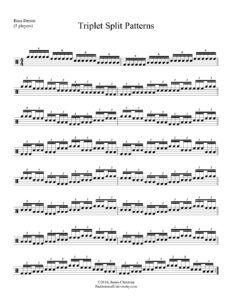
To view the exercise, click on the image to enlarge or click here to download in PDF format.
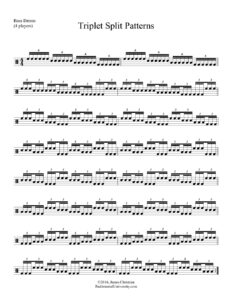
To view the exercise, click on the image to enlarge or click here to download in PDF format.
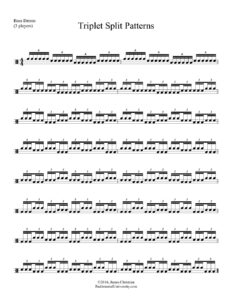
To view the exercise, click on the image to enlarge or click here to download in PDF format.
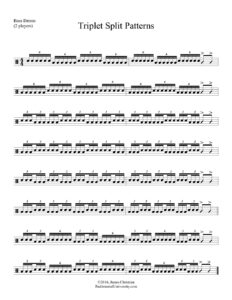
To view the exercise, click on the image to enlarge or click here to download in PDF format.
This exercise has been tailored for different bass line sizes—2 players, 3 players, 4 players, or 5 players. (If you have a larger bass line, simply take the version for 5 players and have two players double one of the parts.)
It covers numerous combinations of sixteenth note triplet split patterns, a skill all bass lines must master. The constantly shifting patterns will keep everyone on their toes. I would recommend practicing each two-measure pattern (indicated by the double bar lines) separately at first. Play each two-measure pattern over and over until your whole section has it down. Once you have each pattern down smoothly, practice the entire exercise from start to finish.
When practicing, be careful to maintain correct note spacing. Usually players tend to err on the side of spacing the triplets too tightly (crushing them), and extra care must be taken to space each note evenly. Sometimes players overcompensate and spread the notes too widely, so be careful to avoid the opposite error as well. Use a metronome to help with pulse control. If possible, get someone with good timing to listen to the exercise and give feedback. If your line works it up, feel free to post a video and link to it in the comments section below.
Happy splitting!
Multi-Tenors Exercise: Triplet Around Patterns
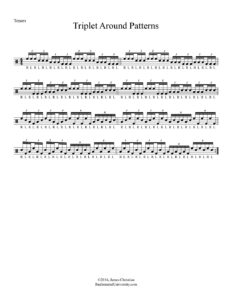
This exercise is a lot of fun to play. It utilizes only four drums, so it can be played on quad-toms, quint-toms, or sex-toms. You especially need two things to play this exercise well:
-
Endurance. As a constant barrage of single strokes, you have to dig deep and keep pushing to the end in order to play this exercise without stopping or slowing down.
-
Fluidity of Movement. Practically every combination of drums is covered here without using crossovers or spock drums. It’s important that you take each pattern slowly until you have the spatial memory to know where you’re going from phrase to phrase. Focus on striking in the proper playing zones and maintaining consistent note spacing.
For added endurance and accuracy practice, play this exercise through 10 times, 20 times, etc. Keep building new goals, and push yourself to get to the next level.


